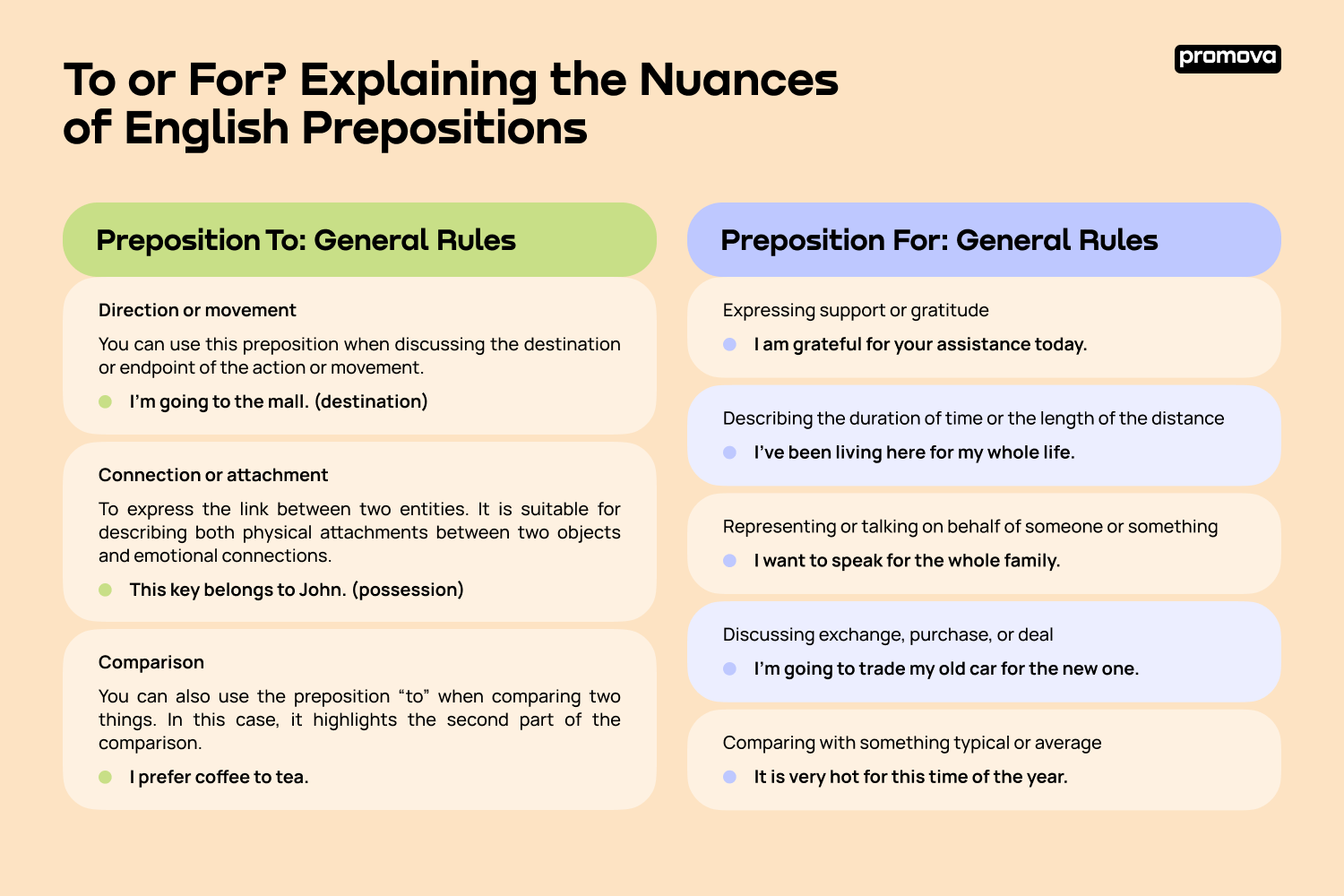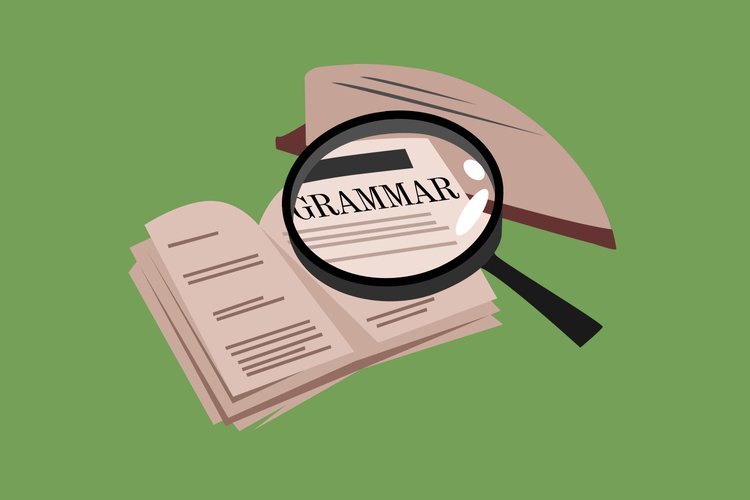To or For? Explaining the Nuances of English Prepositions

Contents
No matter how hard you try, it is almost impossible to become fluent in English without learning basic grammar rules. Sometimes, the simplest (at first glance) things, like prepositions, can cause numerous misunderstandings if you don’t know how to use them properly. For vs to is a classic example of simple prepositions that can be very tricky for unexperienced learners. But don’t worry about that because today, we will do our best to explain the basic rules and the critical difference between these words.
Different Ways of Using For or To
Both prepositions to and for have versatile usage in English grammar. The best way to avoid mixing them up is to memorize particular situations when you can use only one of two options. Keep reading to learn when to use to or for in English sentences.
Preposition To: General Rules
The preposition “to” is probably the one you’ve heard and used a lot, sometimes even without acknowledging why you are doing so. But there are only five main situations when you need to choose this preposition specifically. Use it with:
- Direction or movement
You can use this preposition when discussing the destination or endpoint of the action or movement. It includes physical motion (going from one place to another), travel (referring to transportation or journey destinations), or pointing to a location. For example:
I’m going to the mall. (destination)
I’m flying to Paris tomorrow. (travel)
The park is to the left of the school. (pointing to a location)
Sarah went to her friend. (destination)
Look to the left – there is a beautiful building. (pointing to a location)
- Connection or attachment
Another case of using the preposition “to” is to express the link between two entities. It is suitable for describing both physical attachments between two objects and emotional connections (relationships, possession, and affiliation). For example:
This key belongs to John. (possession)
She is married to her childhood sweetheart. (relationship)
He is loyal to his team. (affiliation)
The note is pinned to the bulletin board. (attachment)
The house belongs to my mother. (possession)
- Comparison
You can also use the preposition “to” when comparing two things. In this case, it highlights the second part of the comparison. For example:
I prefer coffee to tea.
Your school is better compared to the local one.
I prefer high heels to sneakers.
I prefer movies to books.
Her voice is similar to mine.
- Infinitive
The preposition “to” is always used with infinitive verbs. For example:
I like to swim.
I want to travel.
My dream is to find a job in the movie industry.
I don’t want you to feel this way.
I want to introduce you to my family.
- Time
Also, this preposition is used when you aim to say “before” a particular time or as a synonym for the word “until.” For example:
It’s twenty minutes to the end of the movie.
It’s quarter to nine.
We work from dusk to dawn.
I’m with you to the end of the day.
I will work to five today.
3
Preposition For: General Rules
Now that you know how to use to in a sentence, it is time to move to our next preposition, “for.” There are also a few particular situations when you need to choose it:
- Expressing support or gratitude
Thank you for your help.
I am grateful for your assistance today.
If you are not for the team, you are against it.
Thank you for making me coffee.
I’m trying to be grateful for everything that I have.
- Describing the duration of time or the length of the distance
I’ve been living here for my whole life.
We walked for miles along the beautiful coastline.
He slept for a few hours.
The meeting lasted for two hours.
She played the violin for three hours straight.
- Representing or talking on behalf of someone or something
I’ve been working for this company for twenty years.
I want to speak for the whole family.
The coach speaks for the team.
My mother has always been speaking for me at doctor’s appointments.
I want to work for you.
- Discussing exchange, purchase, or deal
I’m going to trade my old car for the new one.
I will buy this book for ten dollars.
I’m going to help you for free.
Can I have this straw for one dollar?
She is going to trade her wireless headphones for the new phone.
- Comparing with something typical or average
He is tall for his age.
It is very hot for this time of the year.
It is costly for a pair of pants.
You are too young for a new haircut.
I am too old for this.
- Instead of “because”
I couldn’t attend the party, for I was feeling unwell.
She returned home to grab an umbrella, for it was raining cats and dogs.
He installed a new application, for he was trying to learn English.
I took this book, for I was recommended to read it.
She took a nap, for she was going to work all night.
- Indicating an arrangement in the future
Is our meeting still on for Thursday?
I have a date scheduled for the evening.
The conference has been rescheduled for September.
The party is planned for Saturday evening.
The concert is confirmed for next month, so mark your calendar!

To vs For: Basic Usage for Reasons and Purposes
At this point, you might think that the difference between these two prepositions is obvious, since both of them have completely opposite usages. Yet, one situation can still be confusing, especially if you are unprepared for it. Take a look at these four sentences:
- I’m going to buy some flowers for Kate’s birthday.
- I want to buy some flowers and give them to Kate.
- I’m going home to feed my dog.
- I was here yesterday for work.
All of them describe a reason or purpose for doing something. So how can we understand when to use to or for in such cases? Luckily, all you need to do is look at the word next to the preposition. If you see the verb, use “to” without hesitation. And if the noun describes the reason or purpose, use “for” instead. Here are some more examples to consolidate the knowledge:
I’m studying hard to improve my grades. (verb)
I’m studying hard for academic success. (noun)
She went to the library to borrow books. (verb)
She went to the library for research. (noun)
They bought a new car to commute to work. (verb)
They bought a new car for convenience. (noun)
He practiced singing to perform on stage. (verb)
He practiced singing for a music competition. (noun)
We go to the park to enjoy nature. (verb)
We go to the park for relaxation. (noun)
She cooks healthy meals to maintain a balanced diet. (verb)
She cooks healthy meals for better health. (noun)
He works overtime to earn extra money. (verb)
He works overtime for financial stability. (noun)
3 Main Rules for Memorizing For vs To Grammar
Now that you know the key differences between these two prepositions, you won’t confuse them anymore. Yet, it might take some time to master them. That is why we want to provide you with three simple and useful rules to determine when to use for or to easily. Remember that:
- If there is an infinitive, always use “to.” There are no other options available. Keep in mind (or even write down) this structure, and it will help you avoid misunderstandings.
Subject + Verb + To + Infinitive Verb…
Kate wants to buy a house.
Joe came to visit his parents.
My job is to look after little kids.
- If there is a noun or pronoun after the preposition, always use “for.” Here is an indicative structure for this one:
Subject + Verb + For + Noun/Pronoun…
Jane is cooking for her family.
I’m learning English for travel.
He bought this gift for his girlfriend.
- If there is a gerund after the preposition, also use “for.”
Subject + Verb + For + Verb + ing…
He practices yoga every day for maintaining his flexibility.
I received a gift from my parents for passing the exams.
She studies hard for improving her grades.
Those are the main rules to summarize the to you or for you grammar. All you need to do is to pay attention to the sentence structure and the following words, add some practice, and you will easily nail all the nuances of English prepositions.
Find the Difference Between For and To with Promova
If you are seeking a comprehensive language-learning solution that caters to your individual needs in your studying journey, look no further than Promova. This international multitool combines various features and benefits to enhance your learning experience, making it easier, more enjoyable, and more effective than ever before. Here are only a few things you can expect from Promova:
- Personal and group lessons. We understand that every learner is unique, so we offer personalized lessons with experienced and qualified tutors. They are dedicated to helping you improve your English skills and achieve your language goals. You can also join group classes that promote collaboration and communication.
- Free trials. For those curious to experience all the Promova benefits firsthand, we offer a free trial lesson to get started. This feature allows you to explore our platform and gives you a glimpse into the interactive learning environment and approach that sets Promova apart.
- Convenient application. Learning on the go has never been easier with Promova’s user-friendly and convenient application. Available for both iOS and Android devices, the Promova app enables you to access your lessons, learning materials, and practice activities, all within the palm of your hand.
- Conversation club. Language fluency is not just about grammar and vocabulary; it also involves confident and natural communication. Promova understands the importance of practice, and that’s why we provide a free Conversation club. Join our vibrant community of language learners, engage in casual conversations, participate in language games and discussions, and refine your speaking skills in a supportive and fun company.
Promova is more than just a language-learning platform; it’s a comprehensive toolkit designed to empower you on your journey to English language proficiency. With all the unique features available for our students, Promova offers a holistic approach to language learning that caters to your individual needs.
Conclusion
In conclusion, understanding what to use for or to in English is crucial for effective communication and language proficiency. While these prepositions might seem similar at first, they have distinct purposes and usage patterns every learner should know. We hope this article was helpful. Today, we want you to share your favorite examples of how to use for in a sentence. And if you tell us yours, we promise to tell you ours!
FAQ
Are there any word pairings that always come only with “for?”
Yes, there are many phrasal verbs and word pairs where you can only use the preposition “for.” It includes phrases: advertise for, approve for, hungry for, pay for, search for, cure for, care for, study for, for free, for good, for a while, for living, etc.
What word pairings are always followed by “to?”
There are plenty of examples, including access to, addicted to, dedicated to, react to, refer to, respond to, attracted to, new to, to one’s surprise, to one’s face, to this day, to some extent, etc. There are also some phrasal verbs that come with this preposition, including look up to, get down to, get around to, etc.
What is the difference between important to and important for?
Although both expressions are common (and correct), they have slightly different meanings. “Important to” usually refers to the subjective value and significance of something for a specific person. “Important for” highlights the objective benefit or purpose that something serves.
Are there any cases when you can use both to and for interchangeably?
No, unfortunately, you can’t use these prepositions interchangeably. Even though they have similar usage in some situations, their meanings still slightly differ. Hence, if you use the wrong preposition, you can completely change the point of your sentence or just make it grammatically incorrect.



Comments